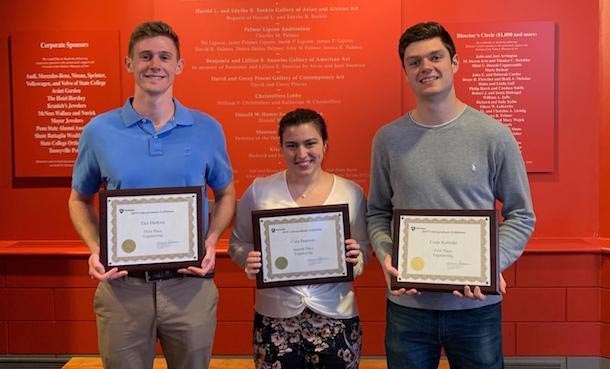
Biomedical engineering undergraduate students Tice Harkins, Cara Pearson and Cody Kubicki with their Undergraduate Exhibition awards. IMAGE: KEEFE MANNING
Artificial heart lab demonstrates the impact of undergraduate research
8/1/2019
By Jamie Oberdick
UNIVERSITY PARK, Pa. — While graduate students and faculty are known for their research work, undergraduates also make significant contributions to the Penn State Department of Biomedical Engineering’s research portfolio. Some examples can be found in the Artificial Heart and Cardiovascular Fluid Dynamics Lab, headed by Keefe Manning, associate dean of the Schreyer Honors College and professor of biomedical engineering.
Manning said undergraduate research provides students with opportunities to apply what they learn in the classroom, gather hands-on experience and acquire skills vital for success in the workplace or graduate school.
“Undergraduate research can be quite useful and complementary to the student experience by sparking interest in pursuing graduate studies,” he said. “Furthermore, undergraduate researchers can provide impactful contributions to the labs where the work is performed, and to scientific knowledge at-large.”
Manning’s students recently were recognized for their work at the Undergraduate Exhibition, held annually at the end of the spring semester on the Penn State University Park campus. The exhibition showcases undergraduate research and artistry across many disciplines at the University. At the 2019 event, four of Manning’s students produced award-winning posters focused on various ways to improve artificial hearts and make them safer for patients, highlighting the impact that undergraduate research can have on society.
In the “Engineering” category, students involved with the Artificial Heart and Cardiovascular Fluid Dynamics Lab nearly swept the top three awards. The first-place winner was Cody Kubicki, class of 2019, mechanical engineering; second place was Cara Pearson, class of 2019, biomedical engineering, and a Schreyer Honors College graduate; and tied for third place was Tice Harkins, class of 2019, premedicine, from the Eberly College of Science, and a Schreyer Honors College graduate. Brady Houtz, rising biomedical engineering senior and a Schreyer Honors College student, took first prize in the University Libraries’ “Undergraduate Research Award: Excellence in Information Literacy” category.
Kubicki’s winning poster, “Fluid Dynamics Study of an Implantable Fontan Circulation Assist Device,” described research on flow patterns in blood circulation devices that are used post-surgery for patients who have undergone a Fontan procedure. A Fontan procedure is a corrective surgery for pediatric patients who possess only a single functioning ventricle, one of two large chambers in the bottom of the human heart that collect and expel blood. The study could help improve device design and reduce dangerous blood clots and red blood cell damage in these patients.
“What was particularly interesting about this project to me was the application of the pump that we were developing,” Kubicki said. “The potential good that this pump could do for thousands of people globally is what motivated me to join this project.”
Pearson’s winning poster, “Determining the Efficiency of Emboli Detection with Doppler Ultrasonography,” focused on developing a protocol for using ultrasound technology for quantitative emboli detection. Emboli are anything, such as a blood clot, air bubble or other object, that can lodge in an artery and cause an obstruction. Her protocol incorporates an algorithm to better detect emboli and is an improvement over the current emboli detection system, which requires reading a sonogram and is prone to human error.
Pearson said her undergraduate research gave her practical work experience that she has already applied to her career.
“I learned a lot of lab skills and information about how to perform great research,” she said. “This really helped me in my past two internships at Merck and it will help me at my new full-time job at Merck, since they did not have to teach me all of the lab skills that I had already acquired working in Dr. Manning’s lab.”
Harkins’ winning poster was titled “Development of a Micro-Particle Image Velocimetry Platform to Study Thrombosis In Vitro.” It covered his research studying the potential effects that surface irregularities on materials used to construct implantable mechanical pumps may have on the flow of blood, and how these irregularities could potentially cause device-induced blood clots.
Harkins said his research focus choice was personal.
“I have a family history of heart disease, so I am personally motivated to study cardiovascular science and the treatments of heart disease so that I can one day help others,” he said.
Houtz’s winning poster was titled “Effects of Elevated Beat Rate on the Hemodynamics of the Penn State Pediatric Ventricular Assist Device.”
His research focused on the Pediatric Ventricular Assist Device (PVAD), which can be used as a bridge-to-transplantation device for infants with congenital heart disease and whose only treatment option is a heart transplant. A challenge with devices like the PVAD is a high risk of life-threatening blood clots over time due to areas of low-flow that allow clots to form. His research has found promising indications that the Penn State-produced PVAD is capable of functioning at a naturally elevated pediatric heart rate that produces a level of blood flow which reduces the risk of blood clots.
“I think that the heart is a complicated and beautiful system, so I was always wanting to learn more,” Houtz said. “Once I joined Dr. Manning’s lab, I wanted to work on a pediatric project which would give me the opportunity to do research on a device that could potentially save hundreds of babies every year. It goes beyond what I learned in the classroom; I’m actually doing the work.”

